This was published 3 years ago
David Dalaithngu was a mesmerising movie presence
By Garry Maddox
Warning: This story contains the name and images of a deceased Indigenous person. His image has been reproduced with his family’s consent. His family requested that he be referred to as David Dalaithngu for a period immediately after his death under posthumous cultural naming practice. They later advised that he can be again referred to as David Gulpilil so that his name, work and legacy - as he wished - can continue to be recognised.
David Dalaithngu: July 1, 1953 - November 29, 2021
David Dalaithngu was more than just Australia’s first great Indigenous actor. He was one of the country’s finest actors from any culture at any time — a charismatic, mesmerising, loose-limbed presence on screen for 50 years from the 1971 film Walkabout to the documentary My Name Is Gulpilil this year.
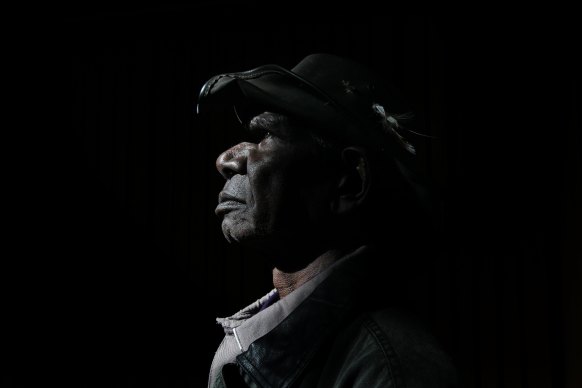
David Dalaithngu ahead of the National Indigenous Arts Awards where he received a Red Ochre Award for a lifetime of achievement.Credit: Dean Sewell
Dalaithngu, who has died at the age of 68, featured in the country’s two biggest hits at the Australian box office, as Neville Bell in Crocodile Dundee (1986) and King George in Australia (2008). His family has requested he be referred to as Dalaithngu and the name he was more commonly known by not be used.
He was compelling as the wise Fingerbone Bill in Storm Boy (1976) and as tracker Moodoo in Rabbit-Proof Fence (2002). And he reached new heights when cast in lead roles for the first time in his 40s by director Rolf de Heer, playing a conflicted tracker in The Tracker (2002), narrating the comic drama Ten Canoes (2006) then playing an Aboriginal elder whose life falls apart in Charlie’s Country (2013).
On stage, he shone in the autobiographical one-man stage show Gulpilil, which was directed by Neil Armfield and premiered at the Adelaide Festival in 2004. His notable television roles include The Timeless Land (1980) and The Leftovers (2017), and he has been the subject of more documentaries than probably anyone in the country, including Gulpilil: Man of Two Worlds (1979), Walkabout To Hollywood (1980), Gulpilil: One Red Blood (2002), Another Country (2015) and My Name Is Gulpilil (2021).
While Dalaithngu was also a dancer, singer and painter, his acting career brought many accolades, including best actor for The Tracker at the Australian Film Institute Awards and best actor for Charlie’s Country at the Cannes Film Festival’s Un Certain Regard section, Australian Cinema and Television Arts Awards and Asia Pacific Screen Awards.
But Dalaithngu’s impact was the profound sense of culture and connection to Country that he brought to his performances and the way he blazed a trail for other Indigenous actors and filmmakers. As long-time friend Jack Thompson has said, there was only Robert Tudawali in the 1955 film Jedda before him.
Witiana Marika, who replaced an unwell Dalaithngu as Grandfather Dharrpa in the 2020 film High Ground and regards him a father by kinship, has described him as “a special and powerful man” and a role model for showing the world “a real Yolngu person” through his films.
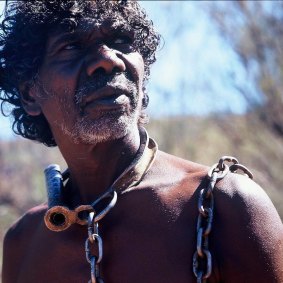
Dalaithngu in Rolf De Heer’s film The Tracker (2002).
Well-known Indigenous writer, director and actor Leah Purcell says she learnt subtlety from Dalaithngu. “My hero when I was growing up was Doris Day,” she says. “But it wasn’t until I watched [Dalaithngu] that you go ‘that’s acting’. There will never be another David ... his intelligence, his knowing, his cheekiness.”
A Yolngu man of the Mandjalpingu clan in Arnhem Land, he grew up with a largely tribal lifestyle in the bush as a twin, to Mary, as well as going to school in Milingimbi and Maningrida. The name “David” was given to him by missionaries.
His life changed when British director Nicolas Roeg visited the remote north, seeking to cast the role of an Aboriginal boy who helps a teenage white girl (Jenny Agutter) lost with her younger brother (Lucien John) in the outback for Walkabout. He discovered Dalaithngu, who was then aged about 14, though the actor admitted late in life that he did not know exactly how old he was. While wrongly credited as David “Gumpilil”, his performance brought international attention.
In subsequent travels overseas, Dalaithngu’s celebrity was such that he dined with the Queen and, as he says in My Name Is Gulpilil, met John Lennon, Jimi Hendrix, Muhammad Ali, Clint Eastwood, Bruce Lee and Bob Marley, who showed him how to smoke what he called ganja.
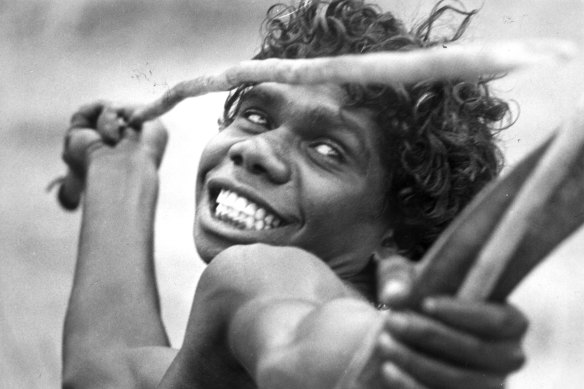
David Dalaithngu as he appears in the movie Walkabout, 1971.
After a beloved role in Storm Boy, he played Billy alongside Dennis Hopper in the bushranger western Mad Dog Morgan (1976). He was a man accused of murder in Peter Weir’s evocative The Last Wave (1977) and, after a scene-stealing comic role in Crocodile Dundee, he returned for Crocodile Dundee II (1988).
There were also appearances in international films — as “Aborigine” in The Right Stuff (1983) and “David” in Wim Wenders’ ill-fated Until The End of the World (1991).
But Dalaithngu found richer and more complex roles as more stories of the country’s history of Indigenous-white history were told.
Phillip Noyce, who directed him in Rabbit Proof Fence, calls Dalaithngu the most subtle actor he has ever worked with. “Brought up learning traditional ways, David was the world’s most prominent embodiment of Australian Aboriginal culture for 50 years,” he says. “He was a living national treasure and a living history of an incredibly vital First Nation culture.
“That’s not to suggest that his success as a performer was solely dependent on his singular Aboriginal ways. David was a skilled dramatic actor, imbued with a remarkable screen presence and intelligence.”
But there were also troubles in Dalaithngu’s life that meant stretches when his brilliance was lost to film and television. With fame came alcohol and drugs; he has said that John Meillon taught him how to drink (and act while drunk) on Walkabout and he fell under the influence of the hard-living Hopper on Mad Dog Morgan.
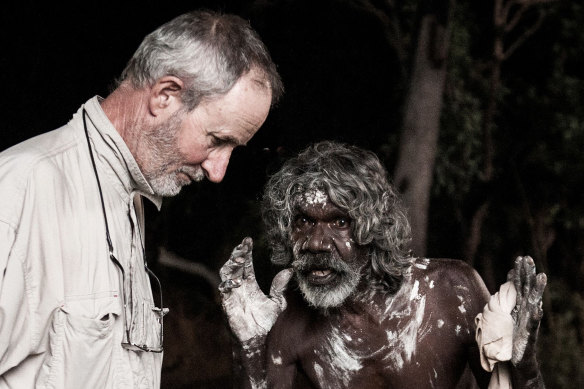
Rolf de Heer and David Dalaithngu on the set of Charlie’s Country in 2013.
Having worked with de Heer on The Tracker, Dalaithngu had been down to co-direct and star in Ten Canoes until a tribal dispute with his community in Arnhem Land’s Ramingining saw him leave for Darwin, fearful of being speared.
Drinking heavily, Dalaithngu joined the homeless population known as the Long Grassers before being jailed for assaulting his partner. When de Heer visited him in Darwin’s Berrimah Prison, he found his friend was a dispirited shell of the usually proud, charismatic actor.
But when Dalaithngu said he wanted to make more films, de Heer started writing Charlie’s Country in the hope it would give him purpose and help keep him away from drinking and smoking. It was a story about an elder who tries to live the old ways in the bush but, after ill health and heavy drinking, lands in a Darwin jail.
While there were parallels, De Heer says Dalaithngu’s acclaimed performance was not autobiographical. “I see a lot in Charlie’s Country that isn’t David at all,” he says. “In the scene when he’s in hospital with his mate who is clearly not long for this world, the grief just blew us away when we were doing it.”
De Heer describes Dalaithngu as a genuinely great actor whose brilliance was both instinctive and intellectual in the Indigenous cultural sense and that he had an “uncanny ability to engage with the camera and treat it like a friend”.
Not just the first Aboriginal actor playing three-dimensional roles on screen, he was “more three-dimensional than most white actors were up until that point in Australian films ... David just got people thinking, my God, we want more of that”.
But de Heer also notes Dalaithngu’s proper education stopped when he was 16 and he spent most of his time away, which was unanchoring in his life: “David used to say he’s a man of two cultures — he lived in two worlds. He’s not. He’s a man of no world. He didn’t fit into either world.“
Baz Luhrmann, who directed Dalaithngu in Australia, called him “a unique person and a unique Australian”.
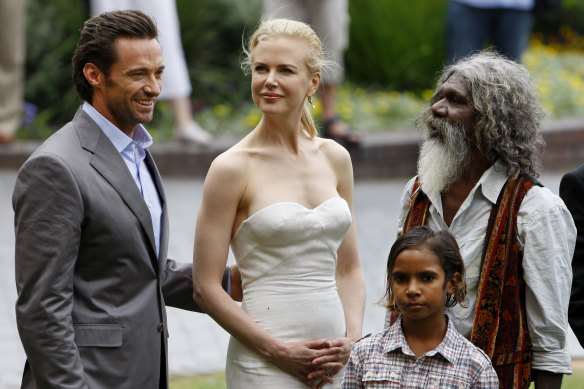
Actors, from left, Hugh Jackman, Nicole Kidman, Brandon Walters and David Dalaithngu pose for photos following press conference for Australia in 2008.Credit: Mark Baker
“I don’t think we can understand quite enough what he has brought to this country in terms of being a storyteller from a culture of storytelling,” he says. “There was just no one like [Dalaithngu]. His passing will be something that the entire nation will go, ‘what a loss’. He’s just been part of us for so long.”
Luhrmann says that making Australia, he “surfed off the energy of his wisdom and his sense of the land and who he was. I was always learning around David.”
Such was Dalaithngu’s early fame that he appeared on This Is Your Life when still in his late 20s in 1979. Asked what he wanted to achieve, he said: “I want to do something not only for me but I’m doing it for Australia and for my people and for our culture”.
He was made a Member of the Order of Australia (AM) in 1987, was awarded a Centenary Medal for his Australian contribution to society in 2001 and won the Australia Council’s Red Ochre Award for his contribution to Aboriginal arts in 2013. Before the ceremony at the Sydney Opera House, he told this reporter with a laugh that he remembered dancing in a lap-lap — “naked!” — for the Queen when the famous building opened in 1973.
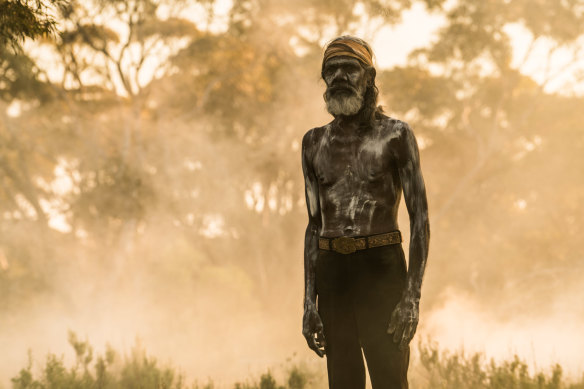
David Dalaithngu during a scene from Cargo.
After being given six months to live when diagnosed with lung cancer in 2017, Dalaithngu lasted another four years during treatment at Murray Bridge outside Adelaide with what he called “white fellas medicine”.
Having asked de Heer and his director partner Molly Reynolds for one more film together, they collaborated on My Name Is Gulpilil, which showed him looking back over a life of extreme highs and lows. The couple pledged to return Dalaithngu to his beloved country, Gulparil, after his death.
His wives both traditionally and in a Western sense have included Airlie Thomas, Robyn Djunginy and Miriam Ashley. He is survived by seven children: Jida, Milan, Makia, Andrew, Jamie, Phoebe and Malakai.
Fascinating answers to perplexing questions delivered to your inbox every week. Sign up to get our new Explainer newsletter here.